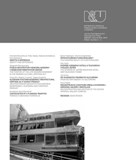SLOVENIAN POST-WAR MODERNIST ARCHITECTURAL HERITAGE AS A TOURIST PRODUCT
SLOVENIAN POST-WAR MODERNIST ARCHITECTURAL HERITAGE AS A TOURIST PRODUCT
Author(s): Matevž Juvančič, Sonja Ifko, Tadeja ZupančičSubject(s): Cultural Essay, Political Essay, Societal Essay
Published by: Historický ústav SAV, v. v. i.
Keywords: post-war modern architecture; socialist regime; cultural tourism; heritage preservation; heritage interpretation
Summary/Abstract: INTRODUCTION RESEARCH AIMS AND GOALS The aim of the paper is to illustrate the tourism potentials of modernist architectural heritage dating from the period of the socialist regime in Slovenia. To define the potentials of modern and postmodern architecture – not only from the aspect of its significance for architectural development, but also in terms of its future significance for economic development – we decided to examine its potentials through the use of a methodology that defines its potentials within the domainis of culture and tourism promotion. We have studied three sites (one from Velenje, one from Ljubljana, and one from Maribor), for which we assessed and addressed their development from the standpoint of their inclusion into the range of cultural and tourism offerings, aspects which have, so far, not been examined. Consequently, our goal is to identify the potentials of modernist architectural heritage for sustainable cultural tourism as a new resource working towards its reuse and redevelopment, based on the the three case studies from Slovenia. In accordance with the ATRIUM project, which is described in the next chapter, we aim to show that the regional and transregional context of cultural tourism may stimulate the development of local actions towards the promotion of modernist architectural heritage, regardless of potential political or historical connotations. PROJECT ATRIUM: AN OPPORTUNITY TO PROMOTE THE ARCHITECTURAL HERITAGE OF POST-WAR MODERNISM AND ITS TOURISM POTENTIALS The project entitled ATRIUM – Architecture of Totalitarian Regimes of the 20th century in Urban Management, under the SEE Transnational Cooperation Programme within the EU research framework, which concluded in October 2013, was one of the opportunities that addressed the potentials of architectural heritage that was directly determined by specific political contexts. The project itself combined a wide variety of non-comparable ‘totalitarian’ contexts, and explored, among others, the many notions of modernism within this issue. Accordingly, the present article addresses the problem of modernist architecture associated with the sensitive notions of non-democratic political orders, and the difficulties that arise in connection with these extra-architectural concepts. One of the main project goals was to explore the possibilities of their opportunities for economic development, and to include this category of built heritage as a cultural tourist product within the ATRIUM Cultural Route that has been formulated as part of the project. THE DEVELOPMENTAL CONTEXT OF SLOVENIAN POST-WAR MODERNISM The end of World War II witnessed substantial political changes in Slovenia, which became one of the republics of the new socialist Federal People’s Republic of Yugoslavia under the leadership of Josip Broz Tito. Tito’s conflict with Stalin in 1948 and the resulting termination of all contact with the Soviet Union significantly influenced the cultural environment...
Journal: Architektúra & Urbanizmus
- Issue Year: 47/2013
- Issue No: 3-4
- Page Range: 182 - 199
- Page Count: 18
- Language: English

